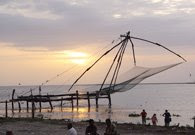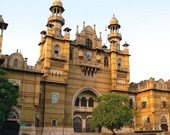Here is the second part of the Future Cities story published in Dataquest. The stories written by me and featured herein are based on personal experience and secondary research. Suffice to say, that the issue was a personal favorite. I would like to thank all the people that took time out for me and were so very generous with there time. They might or might not be the future cities, but they sure are warm (emotionally) cities of India. Again like last time, this is the original and unedited version and would be quite different from the one that got published.
——————————————————————————
Allahabad: Holy modernity
It is a rather cruel irony that the point of reference for the Indian Standard Time or IST, actually lies very close to modern-day Allahabad. Thus every time an Indian checks his watch, he is actually checking what time is it in Allahabad. But for a city that gives us our time, time has more or less stood still. Indeed, Allahabad is completely devoid of any encumbrances of modernity.
A ride through the city on a three-tyred rickshaw driven my a thin skin and bones, would sufficiently convince you to either want to escape to back to modern times or probably enjoy the time and tide of the bygone era. It is quite a numbing experience.
Yet, wait a minute. When I refer to modernity, I do not mean the brands or technology – indeed, the latest and the best would surely be available in Allahabad. I hint at the comfort level of usage of computers in every day life. Even today for an average Illahabadi (resident of Allahabad), computer is a mysterious tool that has great promises but complex functions. It still scares him.
The reason is not hard to gauge, the biggest state in India, Uttar Pradesh, has also been the slowest in terms of IT adoption. There have been a few e-government projects, but they have been quite few and very far between. As, the private sector is more or less non-existent in UP, this has ensured that the computer has not really seeped into the very last nukkad. It is indeed a fact that UP has more or less miss the IT bus.
But there has been a ripple in Allahabad that just might turn into a wave and is worth mentioning. There are lots of prestigious universities and colleges in and around Allahabad, Banaras Hindu University is one and so is the Indian Institute of IT or IIIT Allahabad. It is these institutions that are driving IT adoption and purchase. Thus a majority of equipment is sold to these institutes and this is having its effect on Allahabad.
Today, there are quite a few communities of Allahabad on portals like Orkut. Even the government of India has done its nominal bit by setting up a STPI in Allahabad, thinking that companies would flock to a place like this. But they haven’t really. Till the ground level situation improves drastically not many companies would like to stick their neck in Allahabad.
But before we go, let me underline again the amazing intellectual and intelligent abilities of Illahabadis with an instance. Last year, the High Court in Allahabad was in news for very different reason. Thanks to a committee set up, the honorable high court went online so as to say, by having its own portal, http://www.allahabadhighcourt.com/. The best thing was, all the judgments of the court were not only available now in ODT and ODF format (the court underlined its commitment to FOSS), but they were available in RSS. Thereby making Allahabad court, the only probable court in the whole world to make judgments available through RSS.
Thus one might not be able to really see any outwards signs but a silent revolution of bits and bytes is indeed taking place in Allahabad, driven by institutes like IIIT Allahabad and others. So ignore this holy city at your own peril.
***
Surat: The jewel in the crown
Diamonds and Surat are synonymous, after all 92% of all diamonds in the world pass through the town. Surat is the diamond capital of the world, where much of the polishing and cutting takes place. Surat also happens to be the textile town, with scores of textile mills that lie in and around.
But the ascendancy (if we could term it as ascendancy) of Surat has not been sudden or in spurts. Since the times the Mughal dynasty ruled, Surat started emerging as a premier trade centre. Surat had a major port and trade tries spread all across the world. Also travelers to the annual Haj had to travel through Surat itself. So by the 17th century, Surat was one of the foremost cities of India, so alluring that even Shivaji sacked the city twice to be able to fund his war campaigns. The British East India Company for the first time settled their factory in Surat, before eventually shifting to Bombay. But then, things changed and Surat fell into disrepute.
Things went so bad that the city had to be quarantined because plague that spread across Surat. So that is story of fall of Surat.But now, thanks to vibrant support of the Gujarat government, the economy is again picking up. The state government has chalked an aggressive plan to promote the state as a knowledge hub and make best use of the intrinsic qualities of each city.
Since much of the gem and jewelry centers are present in the city, obviously it would be these firms that would take a lead in terms of modernization efforts. Thus the government announced the setting up of a special economic zone (SEZ) at Icchapore near Surat. Set to be completed this year, the SEZ will supposedly drive the economy of Surat in a big way. There will be quite a few specialized IT companies present in the SEZ that cater to the industry.The textile companies have also had an impact on the domestic market, as the mills like Govardhan, Everest and Motiani Fashions have modernized and used computers for mass scale production. This as coaxed companies like Sun Microsystems and IBM to have a focus on these markets as well. As much of the upper segment of tier I cities nearly taken, vendors are eagerly on the lookout for business potential of tier II and III cities. As many of the big players have given Surat a skip, it is the internal companies itself that have taken the onus of modernizing, like Asian Vision and Gati Softtech Solutions, etc.
Even the channel industry seems to be perking up to the opportunity, evident from the fact that they have been growing at a rate that is as good as any other in Gujarat if not better. The top three players from Surat are Jupiter Automation (annual turnover Rs. 25 crore), Valsons Computer (Rs. 22 crore) and Chopra Enterprises (Rs. 11 crore).
From the perspective of education, Surat offers good facilities like SVNIT, CKPCET, SCET, and others. This bodes well for the city as it looks to ramp up for growth for the future. Much of the growth again will come from the textile and jewelry business itself.
Surat is a vibrant city in close proximity to Mumbai. It is also immensely cosmopolitan city. A century or so ago, Russian literary stalwart Leo Tolstoy had crafted a short-story, wherein the action takes place in a Coffee-house of Surat. In it people from all across the world come together to discuss and debate on issues of varying interests. So there was a Persian mendicant with his African slave, a Hindu Brahmin, a Turk, a Roman Catholic, a Protestant, a Jew, a Chinaman, etc. Even to this day, Surat maintains the spirit of multi-culturism. History might not have been fair to Surat, bringing about constant upheavals in the city’s fortune. Yet, the future beckons brightly, much like the diamonds that pass through the city and dazzle the world with the glitter.
***
Nashik: From Myth to modernity
Traveling through Nashik is an experience by itself, the outskirts of the city is as agrarian as you can get with the farmer and bull duo tilling the land and inside the city there are the multiplexes and the flyovers. So on one hand there exists a Nashik that is extremely rural, and on the very other it is up-to date and modern with all the computer hardware boards, etc. The dichotomy is hard to miss.
Even the agrarian picture is quite different from any in India. The small fields have these small bamboo sticks that jut out, a few feet in length and placed at some small distance apart in a very methodical way. Finally the whole field is covered with a parchment of sorts that conceals the fruit rather brilliantly. But then who does not know about those “sweet grapes” from Nashik. Much of the grape produce of Nashik is converted into fancy wine and sold under brands like Sula, etc. Passing through these fields, one cannot miss the similarities between Nashik and other popular wine destinations like Riviera or Napa valley.
Lying just a few hundred kilometers away from Mumbai, Nashik is indeed the place to be in. There is a hectic buzz of activity, of entrepreneurship, that truly sets the city out. Even the administration seems to have woken up to the potential of promoting Nashik and has started doing so in a small but significant way. There has been a concerted effort to start up industrial zones that more or less help the SMB segment. As of now, there are close to 6 MIDC and 10 Co-operative Industrial Estates in existence in and around Nashik and more are coming up. There has also an STPI established on the Ambad region.
In the past few years, industrial activity has really picked up in Nashik, especially after the launching of a mega SEZ in Sinnar area. Many reputed companies like Mahindra & Mhindra, MICO, Siemens, Crompton Greves, Kirloskar, Reymond steel, Jindal, Brook Bond, L&T, Ceat, VIP, Carbon Everflow, Garware, Jyoti Structures, Samsonite, Datar Switch Gears, Glaxo India etc. have established their units in Nashik. This has led to a spurt in IT adoption in the region. Even the PSUs are aiding the local economy, companies like India Security Press, Hindustan Aeronautics Ltd., Currency Note Press and Thermal Power Station etc. are located in Nashik.
The region also has more than its fair share of educational institutes. Around 9 government ITIs, 13 private ITIs, 2 engineering colleges and numerous other institutes. This ensures steady availability of talent for the industries. The big drawback as of now in Nashik is the power situation, frequent load shedding can be quite a bane. But then it statewide issue and not something specific to Nashik and as and when the issue is resolved for the state so will Nashik benefit.
Due to the close proximity of Nashik to both Mumbai and Pune, it has been touted as an ideal BPO destination. A vindication of the same was when WNS arrived in Nashik after acquiring ClaimsBPO, an offshore division of the US-based Green Snow Inc, which provided HIPPA-compliant BPO services. As of now, around 7-8 non-voice BPO companies, including Mumbai-based Tricom India and WNS Global Services, are working out of Nashik. There are also a close to a half-dozen smaller BPOs that have an average of around 50 each.
To sum up, Nashik is indeed a very good investment opportunity from the perspective of RoI and also the potential of growth. Not only that, the city is also renowned as a pilgrimage center, with the Shirdi close by and Sai Baba looking over the city. In fact, Nashik derives its name from an incident in Ramayana, wherein Lakshman cut off Ravan’s sister Soopankha’s nose (nasika/nak). The history of this region stretches out to pre-historic times. One can find almost everything in Nahik, right from modernity to mythology. The grapes are certainly sweetest, here!
***
Raipur: Emerging out of shadows
Here is a small test, ask any of your friends to identify Raipur on the Indian map, nine times out of ten, he or she will fail. Now, ask your friend where is indeed Raipur and even on this seemingly easy test, many will falter. And that sums up much of the problem with Raipur.
The capital city of new formed Chattisgarh state is not all that well-known on even a national scene. It has been over 6 years now since Chattisgarh was carved out of Madhya Pradesh. Lying on the precious mineral belt in central India, Raipur has a whole lot of mining companies that have set up operations in and around Raipur. Traditionally, the city of Raipur has been described as “an agricultural-processing and saw-milling town”. The city is located centrally in the state of Chattisgarh, and serves as a regional hub for trade and commerce for a variety of local agricultural and forest products. There are several small-scale industries, which include oil milling, soap manufacturing and electrical welding.
Not only that the region is also emerging as an important educational hub. A lot many engineering colleges have come up in and around Raipur providing excellent educational facilities. In fact many domestic IT companies regularly go to these colleges for campus recruitments, companies like TCS, Wipro, Cognizant, iGate, and others. The famous colleges are Raipur Institute of technology, National Institute of Technology, AT College of Electronics and MJ College of Information Technology. These colleges ensure that there is a steady stream of employable talent available in Raipur. Though the government of Chattisgarh was caught in a situation when the Supreme Court came down heavily on the high number of universities cropping up, even Aptech had fallen for the lure and launched a university operations in Raipur.
The state government is also actively wooing IT companies and asking them to set up shop in Raipur and invest through the SEZ way. A few companies are supposedly assessing the possibility, whether it is feasible in the long-term considering the geo-politics of the region.
The government of Chattisgarh is actively promoting the use of ICT for development. In this regards, a host of e-governance initiatives have been launched within the state. Recently the state government launched the first e-Court system in Raipur. In fact, the government has created a vision document that speaks about how it will pursue e-governance initiatives. One of the objective that is representative of all, says, “ICTs will be used extensively in enhancing the productivities and efficiencies substantially in all the sectors of the economy, especially, agriculture, manufacturing banking and services sectors.”
The change is quite evident when one sees the emerging channel industry gaining strength and growing at a healthy rate. There are quite a few strong channel players in Raipur that mainly cater to the industries and the SOHO as well. Some of the names are, Priyanka Computer Services (annual turnover Rs. 22.79 crore), Balaji Computer (Rs. 12 crore) and Shriram Computers (Rs. 8.5 crore).
But the change is very evident, recently, the states and Raipur very first mall, ‘City Mall 36’ was inaugurated. The mall comprises number of national and international brands such as INOX, McDonalds, Big Bazar etc. According to news reports, Raipur is getting ready for 7 more such global malls by end of 2008 namely. Even the TAJ group of
Hotels has started the constructing its Five Star Hotel in Raipur. The government is also actively developing a vast tract of land near the city, dubbing it as Naya Raipur. The place is well-laid and would have the best infrastructure available in the whole of the state. According to many, once this project is completed, moving to Raipur (for IT majors) will not be difficult decision to make.
All these factors are indicative of major change that is happening on the ground at Raipur. For long it has remained under the shadows of bigger cities like Indore, Bhopal, Nagpur and others. Now it is finally ready to break out.
***
Chandigarh: Symbol of the future
Jawaharlal Nehru wanted to prove a point and many with Chandigarh. He envisaged the city to be a metaphor of modernity, a symbol of the tryst that we had embarked on. After having witnessed the bloodiest human migration in history in the form of partition, Nehru decided to build a beautiful capital city for the state of Punjab. He famously proclaimed Chandigarh to be “unfettered by the traditions of the past, a symbol of the nation’s faith in the future.” Like any of the city-builders in history, he would not leave a stone unturned. So the best architects were involved in the project, namely Swiss-born French architect and planner, Le Corbusier and American architect-planner Albert Mayer who was working with the Polish-born architect Matthew Nowicki. And thus Chandigarh came into existence.
Today some 5 decades or so later, one needs to revisit Chandigarh again to assess whether it is still a beacon for modern India or just milestone left behind. Speaking from the perspective of IT industry, Chandigarh has largely been a mixed bag. The biggest draw of the city is definitely the amazing infrastructure, the broad roads and the comfortable housing. Yet, IT companied have not really flocked to Chandigarh, setting up their shops. Rather strange, if one considers the fact that in North India, there is hardly any city that can stand in comparison of Chandigarh, with the possible exception of Gurgaon.
A host companies like Infosys, Quark, Dell, Webart Softech, Netsoft Informatics, and others have already set up base in Chandigarh. The government had some years launched the Mohali SEZ amidst much fanfare, though according to certain observers there hasn’t been much difference on the ground. Not only that, there have been numerous discussions on how well suited Chandigarh is for BPO work, a few companies have indeed set up shop like IBM Daksh, Kalldesk, Bay Infocomm, UCIL and others.
Now, another exciting project is coming up in close vicinity, an IT Township in SAS Nagar. A Consortium formed by Reliance Industries, real estate investor Landmark Holdings, Berggruen Holdings India, subsidiary of a New York-based company, and Punjab-based Yellow Stone, is expected to infuse over Rs 950 crore in the IT township. The project, to be set up within 10 km of the upcoming international airport at Chandigarh, is expected to set aside 60 per cent of its area for IT companies, 30 per cent for housing and 10 per cent for commercial operations. Considering the host of engineering colleges in the vicinity, Chandigarh still has the potential to be a symbol of the future, all it needs now is a big push, that’s it.
***
Coimbatore: Moving up with Speed
Like its beloved son, N Kartikeyan, Coimbatore also seems to be in love with speed. How else can one explain the rapid work that is taking place in Coimbatore. After Kochi, Coimbatore is place in South India that is witnessing a construction boom. And if that was not enough, a new IT park is being constructed by ELCOT and TIDCO.
Infrastructuraly speaking, Coimbatore has always been known for its well designed roads and well though out architecture. Renowned as the Manchester of the East, because of so many textile mills in close proximity. The city’s primary industries are engineering and textiles. The district also houses the country’s largest amount of hosiery and poultry industries. Most of the industries are run by entrepreneurs, often indigenous with family based or community financing. The city’s industrial growth started in 1920’s and accelerated after independence, without any government assistance or the entry of external industrial houses. Of late, information technology companies have started opening offshore development centers in the city.
The result: a robust economy and a reputation as one of the greatest industrial centers in South India. The engineering prowess of Coimbatore can be gauged from the fact that TCS has already established its Centre for Engineering Services.Coming back to the park, according to reports, Wipro is quite keen to be the anchor partner for the park. Whereas there have been enquiries from Satyam, HSBC for back-end operations and a few companies from Bangalore and Chennai too for readymade space in Coimbatore to begin their operations. A CII-commissioned study by Pricewaterhouse Coopers indicates that companies setting up shop in Coimbatore can increase profits by 60 per cent compared to those in metros. Coimbatore has more than 80 engineering and arts and science colleges, so it has an abundance of talent for the kind of workforce required.
The city also boasts of two STPI earth stations, one at PSG- Science and Technology Entrepreneurial Park (STEP) and another at the KG Information Services Limited (KGISL) campus at Saravanampatti. But things are changing steadily. Some of the major industries are Lakshmi Machine Works(LMW), Premier Instruments & Control Limited(PRICOL), ELGI Equipments, Roots Industries, KSB Pumps, Dresser Valves, Flowserve, Janatics, Texmo Industries, Aquasub, Sharp Industries, CRI, Deccan Industries & ITC. Suzlon is also setting up a huge plant for renewable energy.
Also the fact that till quite sometime back, the minister at the Centre, Dayanidhi Maran was quite keen to see Coimbatore as a favored destination also helped.
***
Mangalore: Fishing for big investments
From a sleepy fishing hamlet to being the fastest growing non metro in South India, Mangalore (Mangalooru to be precise) has indeed transformed much over the years. Yet the transition is not that startling, simply because Mangalore always had the potential to emerge as one of the biggest cities of India, even in comparison to ‘former pensioner’s paradise’ that is Bangalore.
The reason is not much hard to find, since the middle ages, coastal Mangalore has always been a vital trading point on the western shore. Thus produce from surrounding areas namely Kerala, Goa and even Maharashtra was traded through the harbors of Mangalore. Thus, over the last many years a number of related industries came to exist in Mangalore. Right from coffee traders to ship building companies like Swan Aquatics, etc. Not only that, there are a few major chemical and fertilizer companies also present in Mangalore like Mangalore Chemical and Fertilizers Ltd. (MCF), Kudremukh Iron Ore Company Ltd. (KIOCL), Mangalore Refinery and Petrochemicals Ltd (MRP), BASF, ELF GAS, etc.
Nonetheless, Mangalore is ready to move to the next level, in fact it is very much doing so and is wooing IT companies in a big way. Infosys is truly the first and the biggest in Mangalore. Spread over an area of 300 acres, Infosys’s campus in Konaje is quite a landmark by itself. Infosys also has significant presence in Blue Berry Hill STPI in Mangalore. Wipro is also actively working on a facility in Mangalore to complement its huge campus in Mysore.
Meanwhile, there has been lot of talk of how well suited Mangalore is for BPO activities. According to many, the region has more scope for BPO than software because of the high education level. Mangalore has plenty of renowned schools and colleges in the city or the near vicinity, thereby supplying a large labor pool. Little wonder, than MPhasis BPO had set up shop in Mangalore. Not only Indian companies but even MNCs are keen to make a move to Mangalore. Take the case of First Indian Corporation; a wholly owned subsidiary of The First American Corporation has started operations in Mangalore.
As the city of Mangalore attracts investment, so is the infrastructure steadily growing. Off late, the Mangalore airport has been operational and there has also been quite some talk of making it international. With a host of engineering colleges in the vicinity (KERC and PA College), there is little doubt that Mangalore is going to be a major draw for IT companies (the IT exports from city will amount to Rs. 1000 crore by 2007 end). What remains to be seen whether this coastal paradise is able to retain its intrinsic charm in wake of all this high-fly investments. One sure hopes so.
***
Mysore: Not a mere satellite
For Mysore, its close proximity to Bangalore is both a boon and a bane. Indeed over the last few years, there has been a major spurt in investments in the hilly town due to the supposed saturation in Bangalore. Companies right from Indian IT majors to MNCs have in some way or the other chalked out a map to make use of Mysore mainly because of its close proximity to Bangalore. And this is quite disquieting.
Before India attained independence, Mysore was regarded as one of the premier princely states of India. Unlike many other royal maharajas who splurged money on themselves and themselves alone, the Wodeyars (the ruling family of Mysore) was certainly not the same. Take the case of Chikka Devraja Wodeyar, who ruled from 1673-1794 and widely reformed the empire by dividing it into sections called as chavadis. Meanwhile, Krishnaraja Wodeyar who ruled from 1902 to 1941 was largely responsible for much modernization of Mysore. Not only was he a great patron of art but also a visionary. He set up numerous educational institutes during his reign, the most memorable being the Indian Institute of Science at Bangalore (he gifted 11 acres of land for it).
Thus, Mysore was much modern before the Silicon magic wand transformed Bangalore. It never did have the big heavy industries, except for Mysore Sandal Oil Factory or Krishnarajendra Mills. Much of the industries were traditional in outlook and small in scale. So while Bangalore hogged the limelight as an IT hub, Mysore continued to retain its old world charm, as the cultural capital of Karnataka. But that is set to change as well.
For the industrial development of the city, Karnataka Industrial Areas Development Board (KIADB) has established four industrial areas in and around Mysore, namely, Belagola, Belawadi, Hebbal (Electronic City) and Hootagalli. This has resulted in fair amount of optimism among IT players about the potential of Mysore. Infosys has made a big splash already by setting up one of the largest technical training center in the world located over an area of 270 acre and can accommodate over 4500 trainees at a time. Wipro has also established its Global Service Management Center (GSMC) in Mysore to complement its facility in Bangalore. There have been a few BPOs also coming up in Mysore, Hinduja TMT launched a 1000-seater sometime back in Mysore
Mysore now boasts of a four-lane high-speed expressway from Bangalore and is hoping that the government keeps its word on providing better infrastructure, connectivity and the much publicized BPO park in Bogadi that would lead to the city’s growth and attract more companies. In the year 2006-07, Mysore contributed Rs. 760 crores to Karnataka’s Rs. 48,700 crore IT exports and has already overtaken Mangalore as the second largest IT center in terms of revenue. But there have been a few controversies as well, namely the tussle between Infosys and the former prime minister Deve Gowda on a range of issues from infrastructure development to things else.
All in all, Mysore needs to be assessed as a city by itself and not due to mere proximity to Bangalore and even on its sole merits it scores wonderfully well. It isn’t a satellite but a planet by its own.
***EOM***















